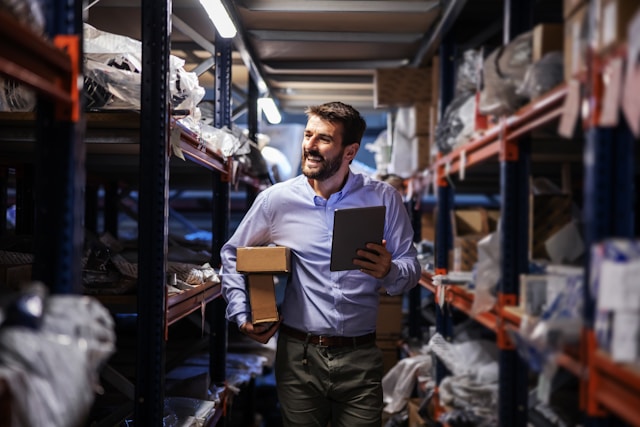Can we get a better kind of clickbait? ERP today hears from retail experts on the technology saving the day for customer experience.
Online shopping can be a real gamble. The common expectations of simple and easy browsing from the comfort of your home don’t always come true. The reality is that many retail companies, despite working tirelessly post-pandemic to make their mark, build a recognizable brand and attract more customers, are missing the trick of creating an easy customer experience.
Attention-grabbing sometimes comes at the expense of functionality. Take for example Spanish clothing retailer ZARA’s online platform, widely recognized for featuring pictures of its clothing worn by extravagantly posed models. Contrary to traditional images, which aim to show customers as much of the item as possible, ZARA has been going for a type of magazine editorial shoot – women crouching on kitchen appliances or leaning over fences in a myriad of funky positions that draw attention and entertain us.
This might have made the brand more recognizable with its own kick, adding to Zara owner Inditex’s net profit jump of 32.5 percent year-on-year for the nine months ending October last year.
But, while not necessarily reflected in the fast fashion retailer’s profit margins, the dubbed “awkward mannequin poses” arguably serve little purpose when a customer is trying to make an informed purchasing decision. With the available pictures rather more imaginative than helpful, the fast fashion retailer has come under fire for unclear item sizing and returns policies, dampening its customer satisfaction ratings on review sites like Trustpilot.
So, is having a well-known, eye-catching brand the most important factor for online retail? In the case of retail and creating a smooth customer experience, maybe it isn’t. And in the era of rapid technological advancements, it might be true that the most revolutionary thing a brand can do is make the shopping experience easy and hassle-free.
Many other well-known and trusted high street brands are also struggling with customer service. For instance, one 2021 Which? survey included the likes of JD Sports, Homebase, Carphone Warehouse and Debenhams as receiving one-star ratings for resolving customer complaints too. So, what can retailers do to fix this service problem?
Technology companies among Oracle, KPMG and Google Cloud have recently been partnering with retailers to help them analyze the experiences of their shoppers, as well as those visiting their competitors. As a sign of some retailers moving to a new era of tech-led capabilities, brands are utilizing technology to enable the personalized targeting of shoppers and connect digital and physical spaces with store staffing information and needs – in all, allowing them to elevate the overall experience.
Achieving omnichannel style and substance
Leading retailers rely on technology across every aspect of their business – Jonathan Attia,
KPMG
Recovering from the blow of the pandemic and the lingering economic uncertainty that has particularly hit retailers and the high street, companies are still navigating these challenges with many looking to find innovative ways to attract customers with better experiences.
Despite the challenging market conditions, Jonathan Attia, partner and head of digital products of KPMG UK, says that the market is evolving quite rapidly, with technology continuing to be a huge driver of change in the retail sector.
“Leading retailers rely on technology across every aspect of their business, be it enhancing their omnichannel and ecommerce experience, making decisions around their physical estate, demand planning or pricing and promotions,” he says, with this reliance likely to continue growing, especially as the application of AI and ML enable more automation, more accurate decision-making and that much sought after personalized shopping experience.
With eyes wary (and weary) of the pressures of tight margins and stiff competition, more retailers are working to streamline their supply chains, reduce waste and improve inventory management to optimize processes.
As a way to help tackle these challenges, KPMG has recently developed a subscription software, Dash, which equips businesses with access to advanced data and analytic capabilities, using ML-driven forecasts to help retailers predict demand more accurately, reducing both overstock and stockouts.
Using three billion external data points, including the likes of demographic data, footfall data, store openings and closings and economic data, Dash is also seeing retailers leverage technology solutions to optimize their pricing, predict workforce demands and enhance loyalty schemes with personalized recommendations.
“At a granular level, we’re talking about things like forecasting store performance with extremely high levels of accuracy, identifying new store locations similar to best-performing stores, highlighting stores that are suitable for expansion or refits, highlighting insights that will improve store performance and suggesting the best products to place on the shelves,” Attia explains.
Since its launch in 2022, Dash has evolved and is now working with some of the leading UK retailers, leveraging the insights of the platform every day to aid decision-making.
Overcoming the last-mile delivery hump
Late shipment could definitely erode how [customers] feel about the retailer – regardless of
the fact that it was the delivery company who caused the delay – Jeff Warren, Oracle
A challenge front and center on consumers’ minds is delivery, especially as services like Amazon Prime have increased the expectation and appetite of consumers to get orders as quickly as possible – sometimes even within hours – thus increasing the stakes for the rest of the retailers sending their goods.
Jeff Warren, VP of Oracle Retail, agrees that delivery remains top of mind for retailers and while “on the business side, deliveries can be costly” he warns that “the impact of a bad delivery experience can impact customer loyalty.”
“This is [determining] where a customer chooses to shop and can have an impact on the bottom line of a retailer which can’t compete with fast deliveries,” Warren explains.
Working to help retailers face these challenges, Oracle has recently partnered with Uber on the Collect and Receive last-mile delivery solution that connects retailers and consumers. It allows companies to rebalance inventory while awarding customers with more choices, including same-day and scheduled delivery options, order pickup and returns to the closest retail or postal location.
Working to enhance last-mile delivery, the solution is supported by the Oracle Retail Data Store and cloud platform technologies, making it possible for retailers to link to Uber Direct, the company’s white-label delivery solution, via pre-integrated APIs. Here, Oracle retailers can start leveraging a faster delivery-as-a-service through Uber, and voila, it can effectively remove the last-mile logistical nightmare from retailers’ workloads.
For consumers shopping on that retailer’s website, access is then granted for an on-demand delivery option for any products that are in stock at a local store near them, with that store and Uber’s technology, and network of drivers and couriers, taking care of the rest.
Facilitating a quicker and smoother shopping experience is no doubt a huge win here, but the Collect and Receive solution is also seeking to help retailers to better understand how a customer prefers to shop and when (whether in-store, online or for collection) as well as maintaining better control over the delivery process.
“For example, some shipments go from warehouses to a variety of outsourced carriers, making tracking and delivery timelines unpredictable and frustrating for a customer. If that customer was counting on the shipment for something like a Santa gift for a child, that late shipment could definitely erode how they feel about the retailer – regardless of the fact that it was the delivery company who caused the delay,” Warren explains.
Ultimately, the connectivity of the two platforms helps eliminate the gap between a sales transaction and customer service. With this service, the retailer maintains the invaluable data they need to better serve the customer during their next interaction while improving overall retail profitability.
Letting data sell the goods with personalization
Frankly, personalization is a hard thing to get right for businesses that don’t have decades of
experience in digital commerce and AI – Alex Rutter, Google Cloud
Another challenge that retailers often grapple with is the struggle to meet consumers’ rising expectations for highly personalized experiences when they shop online. Alex Rutter, UKI director of retail at Google Cloud, admits, “Frankly, personalization is a hard thing to get right for businesses that don’t have decades of experience in digital commerce and AI.”
With generative AI becoming one of the fastest-growing technologies, Rutter sees retailers moving quickly to pilot and explore generative AI tools to further engage with customers.
In a similarly timely development, Google recently expanded its long-term working relationship with British department store firm John Lewis Partnership with a strategic deal worth £100m over the next five years, which targets the transformation of its John Lewis and Waitrose brands.
As part of the partnership, Google is developing a customer data platform to drive consumer personalization, while enabling advanced analytics, audience management, monetization and activation across the platforms. This underpins the service-based architecture for the John Lewis ecommerce services that are already hosted in the Google Cloud Platform.
The main focus of the collaboration, as Rutter explains “involves leveraging the capabilities of AI and ML to enhance services, such as how GenAI can help John Lewis Partnership’s support center agents to improve customer experience consistency, by instantly providing exactly the right product and support information. This will speed up resolution and save partner and customer time.”
But, talking personalization, the topic begs the question of how vendors are helping secure customer privacy of information when organizations draw insights from shoppers’ habits and preferences, with legal frameworks also varying by country and region.
Loyalty schemes and membership data need to be handled carefully and anonymized to
ensure personal data is respected – Ben Williams, KPMG
According to Ben Williams, Dash founder and director, head of data and analytics, KPMG UK, data privacy is definitely on the forefront of retailers’ minds and clients are very conscious of how data is used and shared, even when it is with the admirable intention of trying to improve their customers’ experience.
“Loyalty schemes and membership data can be useful for retailers to understand their customers’ preferences, but it needs to be handled carefully and anonymized to ensure personal data is respected,” Williams explains, while adding that Dash itself does not contain any personal data on individual customers, “and we have collated its wealth of external data anonymously so no individual customer is ever identified.”
The near future vision for retail experiences
With a myriad of retail-oriented technologies, their rapid development is set to continue to encourage organizations to create more personalized and engaging shopping experiences.
Looking to the future, Williams envisions that the evolution of retail capabilities hinges on the integration of emerging technologies such as AI, augmented reality (AR) and IoT.
For instance, Dash uses AR to provide customers with interactive product demonstrations and allows for live tailoring and real-time recommendations. Plus, the Dash team has also seen retailers increasingly using IoT to streamline operations and create smarter, more connected stores.
From Rutter’s point of view, retailers are constantly looking to evolve, and this year, he expects them to be using GenAI to enhance their capabilities for conversational commerce.
“For example, with the ability to create new content efficiently based on data and information, GenAI has the potential to power a virtual stylist that could help consumers find dresses in their size and style,” he predicts.
In addition, continuous pressure to innovate and develop products based on consumer feedback is making it likely for retailers to bring GenAI into their R&D process.
“This will enable them to speed up the process by gathering insights from a variety of data sources, as well as reducing costs and developing quick product concepts,” Rutter says.
From R&D to last-mile delivery, the emerging technology in this sector is offering businesses the opportunity to reinvent every area of the customer experience, quicker than you can say fast fashion. With leading retailers already taking the leap, all these approaches surely foretell a smoother and more intuitive shopping experience – one can hope.




